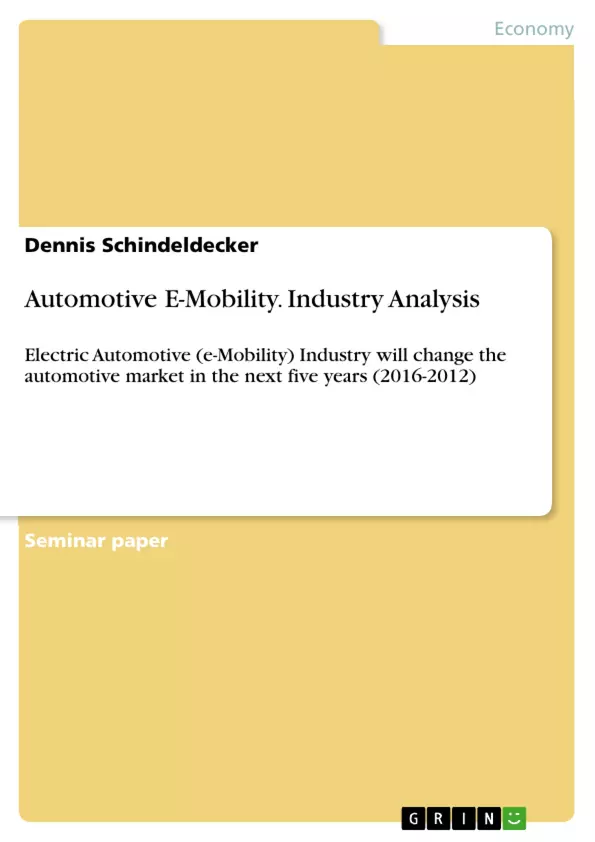The automotive industry is one of the biggest industries, however there is still uncertainty over how electric vehicles (EVs) will affect the industry and if they will become a key part of the mainstream car-buying market. Electric Mobility (e-Mobility) relates to the electrification of the automotive powertrain, and this analysis will refer to EVs as all vehicles for which an electric motor is the primary source of propulsion (including hybrid, range-extended, battery and fuel cell electric vehicles). This paper will analyze the driving forces and key variables of the industry to support company strategies and decision-making.
Inhaltsverzeichnis (Table of Contents)
- Executive Summary of the Analysis results
- STEEP Analysis for the e-Mobility industry
- Sociological Variables
- Technological Variables
- Environmental Variables
- Economic Variables
Zielsetzung und Themenschwerpunkte (Objectives and Key Themes)
This paper analyzes the driving forces and key variables of the electric mobility (e-Mobility) industry. The analysis aims to provide insights into the future of the industry and its impact on the automotive market. It considers how EVs will affect the industry and whether they will become a key part of the mainstream car-buying market. The analysis utilizes the STEEP framework to assess the macro-environmental variables that influence the e-Mobility industry.
- The impact of electric vehicles on the automotive industry
- The driving forces and key variables of the e-Mobility industry
- The role of technology in the development and adoption of electric vehicles
- The impact of environmental regulations and consumer demand on the e-Mobility market
- The economic factors influencing the growth of the e-Mobility industry
Zusammenfassung der Kapitel (Chapter Summaries)
- Executive Summary of the Analysis results: This section outlines the key findings of the analysis, highlighting the projected growth of the global hybrid & electric car industry. It emphasizes the driving forces behind this growth, such as changing mobility needs, increasing demand for eco-friendly transportation, and improving technology.
- STEEP Analysis for the e-Mobility industry: This chapter introduces the STEEP framework as a tool for analyzing the macro-environmental variables influencing the e-Mobility industry. It identifies key variables in each category: technological, environmental, economic, political/legal, and social.
- Sociological Variables: This section explores the specific challenges and opportunities related to consumer expectations for EVs. It discusses the relatively high purchase cost, the need for long-term savings, the importance of features like top speed and acceleration, and the potential safety concerns related to the absence of engine noise.
- Technological Variables: This chapter focuses on the ongoing technological development needed to overcome key barriers to EV adoption. It highlights the demand for innovation in supporting infrastructure, charging technologies, and automotive components, while acknowledging the challenges of long recharge times and limited mileage compared to conventional vehicles.
- Environmental Variables: This section examines the increasing environmental awareness driving demand for EVs. It points to the growing concern over climate change and the tightening of CO2 emission limits, which incentivize manufacturers to include zero-emission vehicles in their portfolios. Additionally, it emphasizes the rising cost of gasoline, a major factor boosting EV sales due to their energy efficiency and independence from limited resources.
- Economic Variables: This chapter highlights the strong growth potential of the e-Mobility industry, driven by factors such as moderate economic growth, job creation, low interest rates, and strong stock markets. It also mentions the substantial investments from EV manufacturers and suppliers, further indicating the industry's growth prospects. The increasing fleet age of cars in many countries is expected to drive more consumers to invest in new cars, further stimulating the demand for EVs.
Schlüsselwörter (Keywords)
This paper focuses on the e-Mobility industry, electric vehicles (EVs), STEEP analysis, consumer expectations, technological development, environmental awareness, economic growth, and market trends. It explores the key factors influencing the industry's growth, including innovation, regulation, and consumer behavior.
- Citation du texte
- Dennis Schindeldecker (Auteur), 2016, Automotive E-Mobility. Industry Analysis, Munich, GRIN Verlag, https://www.grin.com/document/368183



